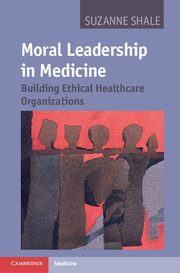Book contents
- Frontmatter
- Contents
- Preface
- Acknowledgements
- Chapter 1 Why medicine needs moral leaders
- Chapter 2 Creating an organizational narrative
- Chapter 3 Understanding normative expectations in medical moral leadership
- Prologue to Chapters 4 and 5
- Chapter 4 Expressing fiduciary, bureaucratic and collegial propriety
- Chapter 5 Expressing inquisitorial and restorative propriety
- Epilogue to Chapters 4 and 5
- Chapter 6 Understanding organizational moral narrative
- Chapter 7 Moral leadership for ethical organizations
- Appendix 1 How the research was done
- Appendix 2 Accountability for clinical performance: individuals and organizations
- Appendix 3 A brief guide to commonly used ethical frameworks
- Index
- References
Chapter 4 - Expressing fiduciary, bureaucratic and collegial propriety
Published online by Cambridge University Press: 05 January 2012
- Frontmatter
- Contents
- Preface
- Acknowledgements
- Chapter 1 Why medicine needs moral leaders
- Chapter 2 Creating an organizational narrative
- Chapter 3 Understanding normative expectations in medical moral leadership
- Prologue to Chapters 4 and 5
- Chapter 4 Expressing fiduciary, bureaucratic and collegial propriety
- Chapter 5 Expressing inquisitorial and restorative propriety
- Epilogue to Chapters 4 and 5
- Chapter 6 Understanding organizational moral narrative
- Chapter 7 Moral leadership for ethical organizations
- Appendix 1 How the research was done
- Appendix 2 Accountability for clinical performance: individuals and organizations
- Appendix 3 A brief guide to commonly used ethical frameworks
- Index
- References
Summary
In this chapter we will be examining practices of responsibility through which medical leaders seek to ensure that their organizational systems allow patients the best care possible, within the constraints of the resources available to them.
Following the account set out in my prologue to Chapters 4 and 5, I shall be discussing practices of responsibility that are recognizable in distinctive clusters of activity called ‘propriety’. Propriety expresses values and beliefs about the right way to do things, values and beliefs that surface in response to the particular issue or problem in hand. In this chapter I shall be focussing on issues that for the most part have to do with effective use of resources. But I should make very clear at the outset that the three proprieties I discuss here – fiduciary, bureaucratic and collegial – are relevant across the entire span of medical management activity. They do not apply only to resource-related concerns. This will be particularly clear in the discussion of fiduciary propriety, but it is a point that might be overlooked when we concern ourselves with bureaucratic propriety.
- Type
- Chapter
- Information
- Moral Leadership in MedicineBuilding Ethical Healthcare Organizations, pp. 99 - 139Publisher: Cambridge University PressPrint publication year: 2011



